
Biete Meskel (House of the Cross) is an Orthodox underground monolith church carved into rock. It is located in Lalibela, Ethiopia. The edifice was built during the Kingdom of Axum. [1] [2] It is part of UNESCO World Heritage Site at Lalibela. [3]

Biete Meskel (House of the Cross) is an Orthodox underground monolith church carved into rock. It is located in Lalibela, Ethiopia. The edifice was built during the Kingdom of Axum. [1] [2] It is part of UNESCO World Heritage Site at Lalibela. [3]
The Zamani Project, based at the University of Cape Town, spatially documented the rock-hewn churches of Lalibela, including Biete Meskel, during four field campaigns between 2005-2009. [4] [5] The documentation was carried with the support of the Andrew W Mellon Foundation and in co-operation with the World Monuments Funds. Over 1200 terrestrial laser scans where acquired to generate 3D models of 14 monuments. Panorama tours combining photographic full-dome panoramas and covering all churches were also generated. Textured 3D models, panorama tours, elevations, sections and plans are available on www.zamaniproject.org.

The Obelisk of Axum is a 4th-century CE, 24-metre (79 ft) tall phonolite stele, weighing 160 tonnes, in the city of Axum in Ethiopia. It is ornamented with two false doors at the base and features decorations resembling windows on all sides. The obelisk ends in a semi-circular top, which used to be enclosed by metal frames.

The Church of Saint George is one of eleven rock-hewn monolithic churches in Lalibela, a town in the Amhara Region of Ethiopia. Originally named Roha (Warwar), the historical and religious site was named Lalibela after the King Gebre Mesqel Lalibela of the Zagwe dynasty, who commissioned its construction. He is regarded as a saint by the Ethiopian Orthodox Tewahedo Church.

Lalibela is a town in the Amhara Region of Ethiopia. Located in the Lasta district and North Wollo Zone, it is a tourist site for its famous rock-cut monolithic churches designed in contrast to the earlier monolithic churches in Ethiopia. The whole of Lalibela is a large and important site for the antiquity, medieval, and post-medieval civilization of Ethiopia. To Christians, Lalibela is one of Ethiopia's holiest cities, and a center of pilgrimage.

Cape Town City Hall is a large Edwardian building, built in 1905, and located in Cape Town's city centre. It is located on the Grand Parade, to the west of the Castle, and is built from honey-coloured oolitic limestone, imported from Bath in England.
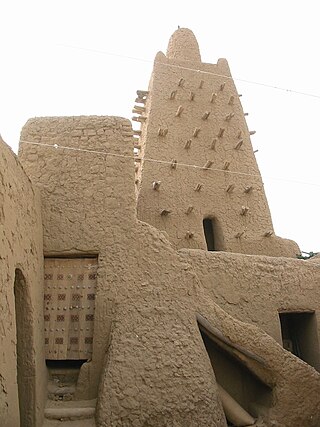
The Djinguereber Mosque, also known as Djingareyber or Djingarey Ber, is a famous learning center in Timbuktu, Mali. Built in 1327, it is one of three madrassas composing the University of Timbuktu. It was inscribed on the list of UNESCO World Heritage Sites in 1988.

The Sulamani Temple is a Buddhist temple located in the village of Minnanthu in Myanmar. The temple is one of the most-frequently visited in Bagan.

The Siq is the main entrance to the ancient Nabatean city of Petra in southern Jordan. Also known as Siqit, it is a dim, narrow gorge and winds its way approximately 1.2 kilometres and ends at Petra's most elaborate ruin, Al-Khazneh. A wide valley outside leading to the Siq is known as the Bab as-Sīq.

Aluka was an online digital library focused on Africa-related material. It focused on globally connecting scholars by building a common platform for online collaboration and knowledge sharing. Aluka's intended audience was higher education and research communities.

The Zamani Project is part of the African Cultural Heritage Sites and Landscapes Database. Zamani is a research group at the University of Cape Town, which acquires, models, presents and manages spatial and other data from cultural heritage sites. The present focus of the Zamani project is Africa, with the principal objective of developing “The African Cultural Heritage Sites and Landscapes Database”. Zamani comes from the Swahili phrase “Hapo zamani za kale” which means “Once upon a time”, and can be used to mean 'the past'. The word is derived from Arabic root for temporal vocabulary, ‘Zaman,’ and appears in several languages around the world.

Fort São Sebastião or Fort San Sebastian located in Shama, Ghana, is the third oldest fortification in Ghana and it was built in 1523. Along with several other castles in Ghana, it was inscribed on the UNESCO World Heritage List in 1979 because of its testimony to the history of European trade, colonization, and exploitation in the region.

Musawwarat es-Sufra, also known as Al-Musawarat Al-Sufra, is a large Meroitic temple complex in modern Sudan, dating back to the early Meroitic period of the 3rd century BC. It is located in a large basin surrounded by low sandstone hills in the western Butana, 180 km northeast of Khartoum, 20 km north of Naqa and approximately 25 km south-east of the Nile. With Meroë and Naqa it is known as the Island of Meroe, and was listed as a UNESCO World Heritage Site in 2011. Constructed in sandstone, the main features of the site include the Great Enclosure, the Lion Temple of Apedemak and the Great Reservoir. Most significant is the number of representations of elephants, suggesting that this animal played an important role at Musawwarat es-Sufra.
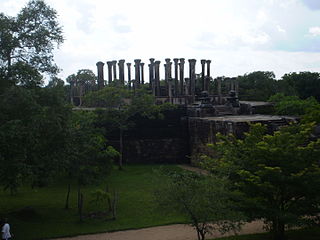
Medirigiriya is a town located in Polonnaruwa District in North Central Province, Sri Lanka. The elevation of the town is 61 m (200 ft). The famous archaeological site of Medirigiriya Vatadage is located about 1 km (0.62 mi) from the town centre.
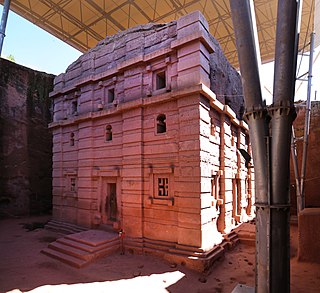
Biete Amanuel is an underground Orthodox monolith rock-cut church located in Lalibela, Ethiopia. The edifice was built during the Kingdom of Axum. It is part of UNESCO World Heritage Site at Lalibela. Biete Amanuel is possibly the former royal chapel.

Biete Abba Libanos is an underground rock-cut monolith Orthodox church located in Lalibela, Ethiopia. It was built during the Kingdom of Axum. It is part of UNESCO World Heritage Site at Lalibela.
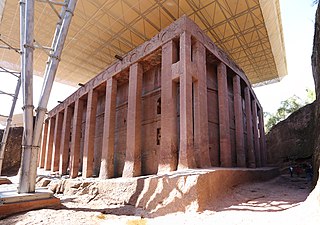
Biete Medhane Alem is an Orthodox underground monolith rock-cut church located in Lalibela, Ethiopia. It was built during the Zagwe dynasty. It is part of the UNESCO World Heritage Site at Lalibela. Biete Medhane Alem is home to the Lalibela Cross.

Biete Maryam is one of the monolithic rock-cut Rock-Hewn Churches, Lalibela of the Ethiopian Orthodox Tewahedo Church. It is part of the UNESCO World Heritage Site at Lalibela.
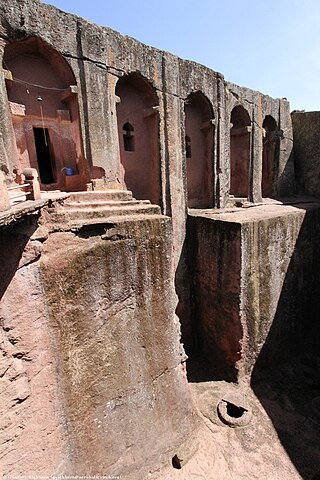
Biete Gabriel-Rufael is an underground monolith rock-cut church located in Lalibela, Ethiopia. The Orthodox church was built during the Kingdom of Axum. It is part of UNESCO World Heritage Site at Lalibela. Biete Gabriel-Rufael is possibly a former royal palace, linked to a holy bakery.

Biete Qeddus Mercoreus is an underground Orthodox rock-cut monolith church located in Lalibela, Ethiopia. It was built during the Kingdom of Axum. It is part of UNESCO World Heritage Site at Lalibela. Biete Qeddus Mercoreus may be a former prison because of ankle shackles found there.
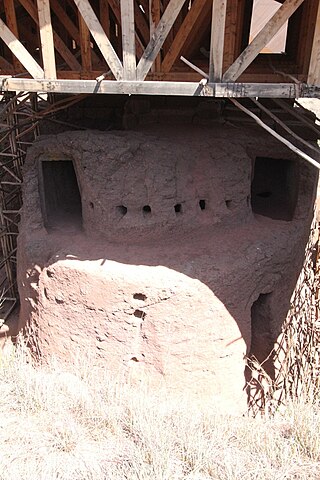
Biete Lehem is an underground monolith church carved into rock. It is located in Lalibela, Ethiopia. It was created during the Kingdom of Axum. It is part of UNESCO World Heritage Site at Lalibela. The name Biete Lehem is from Bethlehem Hebrew: בֵּית לֶחֶם.

The eleven Rock-hewn Churches of Lalibela are monolithic churches located in the western Ethiopian Highlands near the town of Lalibela, named after the late-12th and early-13th century King Gebre Meskel Lalibela of the Zagwe dynasty, who commissioned the massive building project of 11 rock-hewn churches to recreate the holy city of Jerusalem in his own kingdom. The site remains in use by the Ethiopian Orthodox Christian Church to this day, and it remains an important place of pilgrimage for Ethiopian Orthodox worshipers. It took 24 years to build all the 11 rock hewn churches.